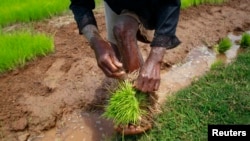How did ancient people from Southeast Asia end up 6,000 kilometers away, on islands off the coast of Africa?
There is no question that they colonized the area over a thousand years ago.
Linguistic and genetic research has confirmed that inhabitants of Madagascar speak a language unique to Southeast Asia and share close ancestry with Malaysians and Polynesians. But until now, there has been no archeological evidence that the island's early settlers were voyagers from across the Indian Ocean.
Researchers from the universities of Bristol, Oxford and Queensland looked at the earliest crops grown in Madagascar and on the eastern African coast, to determine if they were indigenous or introduced. They recovered nearly 2,500 plant remains from 18 ancient settlement sites.
At sites in Madagascar, they were able to identify typical Southeast Asian crops such as rice and mung beans. Excavations on the African mainland and its coastal islands showed primarily indigenous crops - sorghum, pearl millet and baobab.
Writing in the Proceedings of the National Academy of Sciences, the teams present data that Southeast Asian settlers brought Asian subsistence crops with them when they settled in Africa.
"These crops provide the first, to our knowledge, reliable archaeological window into the Southeast Asian colonization of Madagascar."
In addition to Madagascar, the researchers found Asian plants on the nearby Comoros islands. Although people in the Comoros speak African languages and do not appear to have Austronesian ancestry, the presence of rice and mung beans indicates that Southeast Asian settlement extended beyond Madagascar.
They conclude, "it is possible that the Comoros were settled at an early date by a Southeast Asian population that was later genetically and linguistically swamped."





